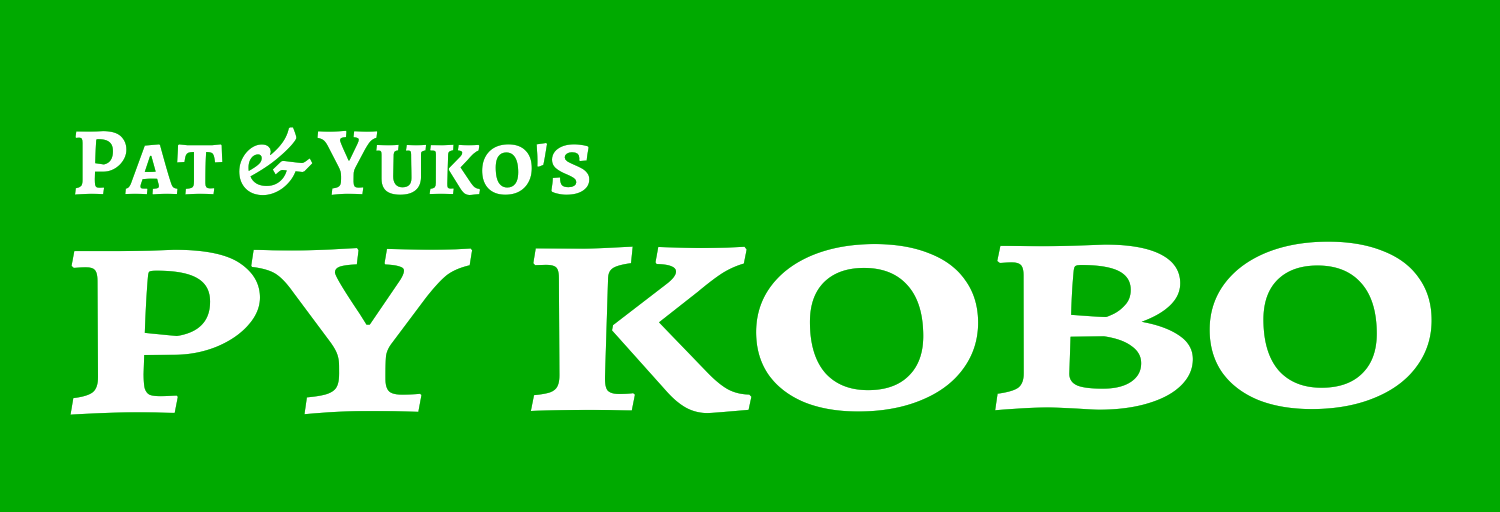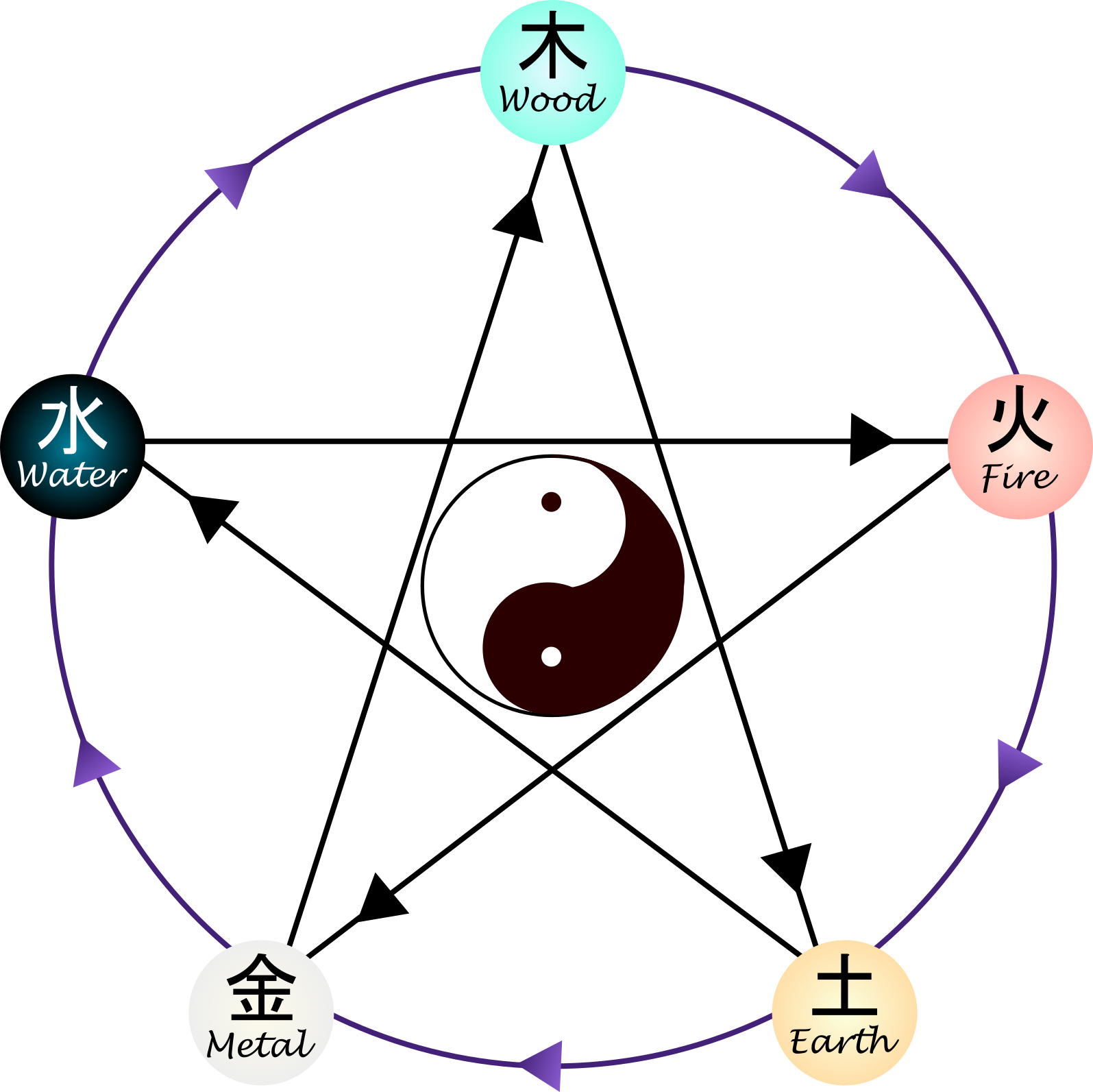- The Theory of Five Elements in Yin-Yang
- The theory of Yin and Yan
- The Five Elements Theory
- Characteristics of the Five Elements and the five cardinal Confucian virtues (Gojo / 五常)
- The relationship of the five elements
- The Five Elements in Yin-Yang (“Inyo-Gogyo / 陰陽inyo五行gogyo“)
- The Five Elements in Yin-Yang and health
- The Five Elements in Yin-Yang and Four Pillars Astrology
The Theory of Five Elements in Yin-Yang
The theory of Five Elements in Yin-Yan is a thought that was born in ancient China from the theory of Yin-Yang and the Five Elements. This thought, which attempts to explain all phenomena in the natural world, was born in the Han dynasty by combining Yin-Yang theory and the Five Elements theory by Zou Yan, a philosopher of the Spring and Autumn period and the Warring States period in China, and had a great influence on subsequent Chinese philosophy. It became the basic principle of Japanese Onmyodo.
Confucianism, Buddhism, and Taoism also adopted the thought of the Five Elements in Yin-Yan. Also the thought of the Five Elements in Yin-Yan is used as a way of thinking such as Chinese medicine and fortune-telling.
In Japanese the theory of Five Elements in Yin-Yan is called “Inyo-Gogyo / 陰陽五行“.
*Yin: 陰
*Yan: 陽
*Five Elements: 五行
The theory of Yin and Yan
In ancient China, all things were thought to be divided into two opposite qi (energies/characteristics) called yin and yang. This way of thinking is called yin-yang thought. This idea predates the Five Elements Theory, and is said to have been preached by an emperor in ancient Chinese mythology, or even before that.

This way of thinking is that there is no good or bad or superiority or inferiority of which nature is bad, all things in the world can be divided into ‘yin’ nature and ‘yang’ nature. It is believed that these two natures are maintained in balance with each other while changing proportions.
For example, a light classified as positive and a shadow classified as negative cannot exist without either one of them. In addition, while light and shadow have contradictory properties, the proportions also change, with more light during the day and more shadows at night.
The Five Elements Theory
The Five Elements Theory is said to have been created by the First Emperor of the Xia Dynasty of ancient China (around 2070 BC to around 1600 BC). This theory is based on the thought that all things in the world are made up of the five elements of wood, fire, earth, metal, and water.
Characteristics of the Five Elements and the five cardinal Confucian virtues (Gojo / 五常)
The five elements of wood, fire, earth, metal and water have their own characteristics and properties. In addition, the five virtues inherent in human beings: 仁 benevolence (sympathy), 礼 etiquette (respectfulness), 信 believe (faith), 義 righteousness (fulfillment of duty), and 智 wisdom (development of wisdom). There is a way of thinking called Gojo 五常, which is applied to the five elements.
Properties of Wood
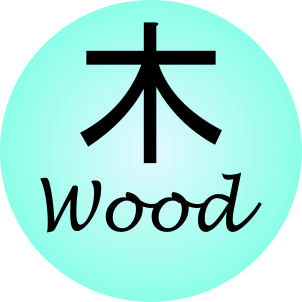
The trunks and branches of trees are twisted and twisted, but they continue to grow straight toward the sun. There is a curving property that the tree grows.
tree-like properties : growth, elongation, softness, smoothness, freedom
Effect : Wood absorbs nutrients from Earth and suppresses Earth. Also Wood is adjusted to Metal and helps with Fire.
Jin of Gojo : Heart of Benevolent 仁, gorgeous, and compassionate heart
Properties of Fire

It has a burning property that causes flames to flare up.
Flaming properties : heat, rising, bright
Effect : Fire melts and suppresses Metal. It also adjusted to Water and helps Earth.
Rei of Gojo : Heart of Etiquette 礼, valuing hierarchical relationships and earnestly showing gratitude.
Properties of Earth
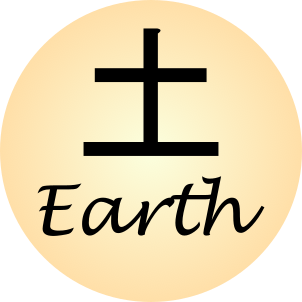
There is a farming property that grow crops and help harvest them.
Properties like earth, the mother of all things : Nurture, accept, change, materialize
Effect : Earth suppresses Water. It also adjusted to Wood and helps Metal.
Shin of Gojo : Heart of believe 信, gentle, vulnerable, sincere and cherishing people
Properties of Metal
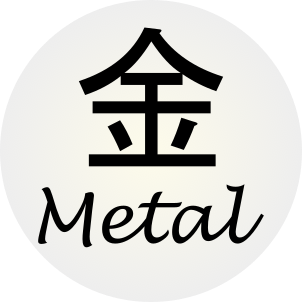
It has a changing property that is easy and constant to change.
Metal-like properties : Cool, clean, astringent
Effect : Metal suppresses Wood. It is also adjusted to Fire and helps Water.
Gi of Gojo : Heart of righteous 義 that respects reason and rules, and is deeply devoted to justice and loyalty.
Properties of Water
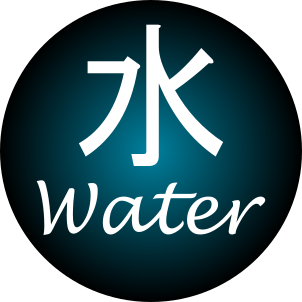
It has the property of moisturizing and flowing downwards like water.
Water-like properties that are the source of life : Cold and cool, moisturizing/moisturizing, flowing downward
Effect : Water extinguishes Fire and regulates Fire. It also nourishes Wood and is adjusted to Earth.
Chi of Gojo : Heart of Wisdom 智 that observes things and has premonitions before acting.
The relationship of the five elements
These five elements have 3 relationships of “Sojo / 相生” where they cooperate and help each other, “Sokoku / 相剋” where they hurt each other, and “Hiwa / 比和” which becomes stronger by having the same nature. In the Hiwa relationship, there is a synergistic effect in which the same qualities are combined, but it is said that if it goes in a good direction, it will get better, and if it goes in a bad direction, it will get worse.
Sojo / 相生
It is a relationship of complementary neighbors. The relationship between neighbors is said to be good.
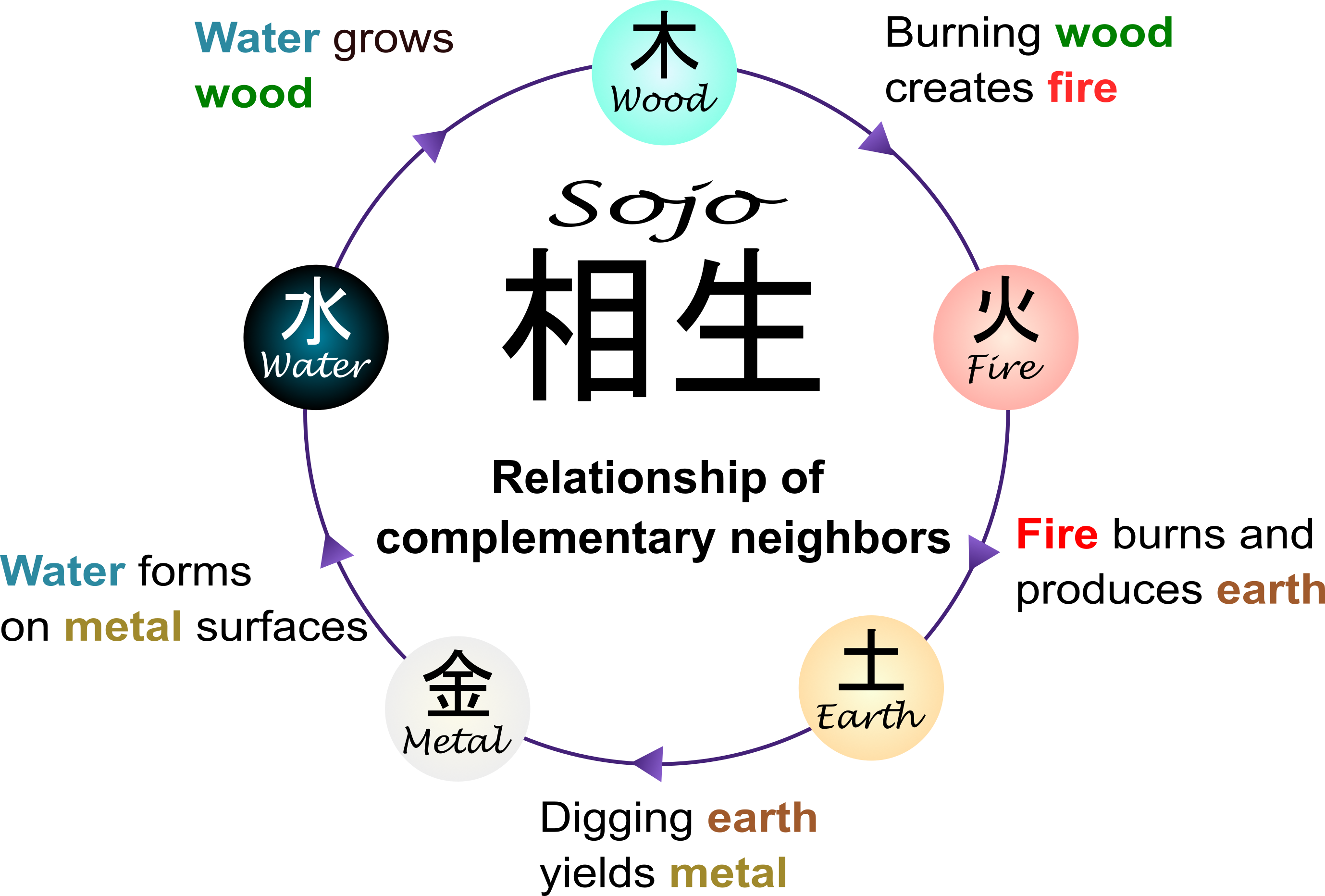
- Burning wood creates fire.
- Fire burns to ashes and creates earth.
- Digging earth yields metal.
- As the metal cools, water forms on the surface.
- Water makes wood grow.
Sokoku / 相剋
It is a relationship of opposition to each other. Face-to-face relationships are said to be restraining and regulating each other.
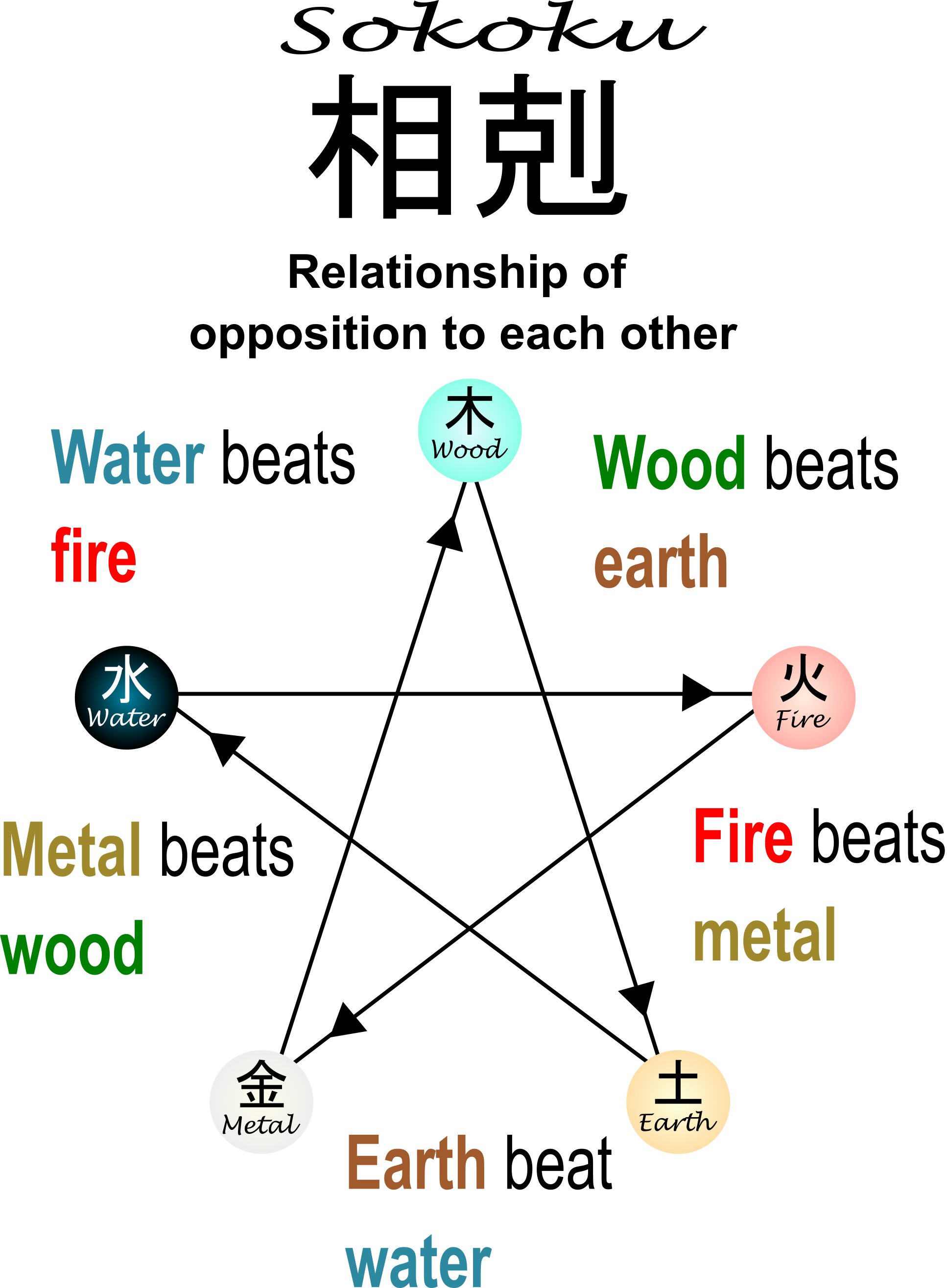
- Wood grow by absorbing nutrients from earth.
- Fire melts metal.
- Earth holds back water.
- Metal cuts down wood.
- Water puts out fire.
These five conflicting relationships prevent each other from becoming too strong.
The Five Elements in Yin-Yang (“Inyo-Gogyo / 陰陽inyo五行gogyo“)
By classifying things into five elements, yin and yang, the five elements of yin and yang enable consideration of their relationships, and have been incorporated into calendar studies and medicine. This “Inyo-Gogyo / 陰陽五行” was introduced to Japan during the Asuka period (592-710) and is said to have been the basis of Onmyo-do, which was abolished in the Meiji period.
Main division of the Five Elements in Yin-Yang
| Five elements | Wood | Fire | Earth | Metal | Water |
|---|---|---|---|---|---|
| Yin-Yang | Yang | Yang | Yin | Yin | Yin |
| Four Gods and Five Beasts | Azure Dragon (青龍) | Vermilion Bird (朱雀) | Qilin (麒麟) or Yellow dragon (黄龍) | White Tiger (白虎) | Black Tortoise (玄武) |
| Season | Spring | Summer | Doyo* | Autumn | Winter |
| Climate | Wind | Heat | Humidity | Dry | Cold |
| Planet | Jupiter | Mars | Saturn | Venus | Mercury |
| Month | Jan., Feb., Mar. | Apr., May, Jun. | Jul., Aug., Sep. | Oct., Nov., Dec | |
| Direction | East | South | Center | West | North |
| The ten Heavenly Stems / 十干 | 甲 (Kinoe) 乙 (Kinoto) | 丙 (Hinoe) 丁 (Hinoto) | 戊 (Tsuchinoe) 己 (Tsuchinoto) | 庚 (Kanoe) 辛 (Kanoto) | 壬 (Mizunoe) 癸 (Mizunoto) |
| The twelve zodiac animal signs / 十二支 | |||||
| Time | Morning | Noon | Afternoon | Evening | Night |
| Day of week | Thursday | Tuesday | Saturday | Friday | Wednesday |
| Five solid organs | Liver | Heart | Spleen | Lung | Kidney |
| Five hollow organs | Gallbladder | Pericardium | Stomach | Large intestine | Bladder |
| Five sense organs | Eyes | Tongue | Mouth | Nose | Ears |
| Five parts of body | Tendon / Ligament | Blood vessel | Muscle | Skin | Bone |
| Five tastes | Sour | Bitter | Sweet | Spicy | Salty |
| Five parts where the state of the five organs is reflected on the body surface | Nail | Face | Lips | Body hair | Hair |
| Five emotions | Anger | Joy | Worry | Sorrow | Fear |
| Colour | Blue (Green) | Red (Crimson) | Yellow | White | Black |
| Five cardinal Confucian virtues | 仁 benevolence | 礼 etiquette | 信 believe | 義 righteousness | 智 Wisdom |
| Five grains | Wheat | Common millet | Foxtail millet | Paddy rice | Beans |
| Five fruits | Plum | Apricot | Jujube | Peach | Chestnut |
| Five animals | Chicken | Sheep | Cow | Horse | Pig |
| Five numbers | Three | Two | Five | Four | One |
*Doyo: The first days of spring, summer, autumn, and winter were called “立春 risshun”, “立夏 rikka”, “立秋 risshu”, and “立冬 ritto” when the lunar calendar was used. Doyo, strictly speaking, refers to the eighteen-day periods before these four days. Today, however, doyo generally only refers to the eighteen-day period before the first day of autumn. The first day of autumn is called risshu in Japanese, and it falls around the 8th of August on the calendar used now. The calendar says autumn begins after the doyo period, but the doyo period is the hottest time of the year. The doyo period is in midsummer.
The Five Elements in Yin-Yang and health
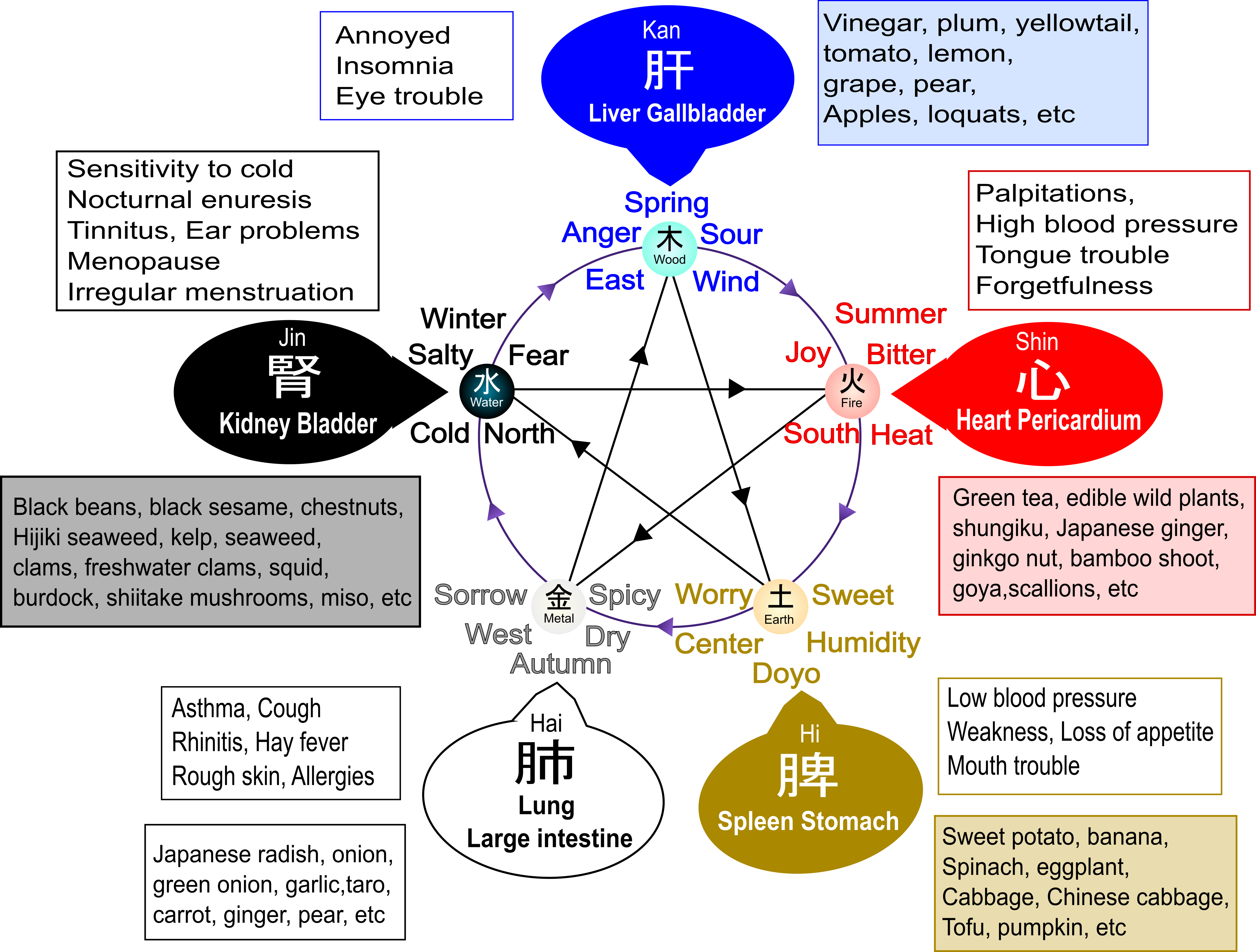
In Oriental medicine, we apply the idea of five elements and divide the body into five functions: “肝 Liver“, “心 Heart“, “脾 Spleen“, “肺 Lung” and “腎 Kidney“. Like the elements of the five elements, these “五臓 Five organs” are made up of each other in balance. By looking at the five organs from the perspective of the five elements, you can consider troubles that are likely to occur, parts that are likely to cause symptoms, and foods that suit your constitution.
The five elements and organs are deeply related. For example, if the function of the kidneys, which belongs to “water element”, deteriorates, it is thought that coldness and ear troubles are more likely to occur. In order to improve “water element” malfunction, it is said that it is good to supplement with salty foods such as miso and salted squid, which are “water element” of “五味 five tastes (Sour, Bitter, Sweet, Spicy, Salty)”. In this way, there is also a way of thinking that attempts to improve physical condition by supplementing foods that correspond to five elements against organ malfunction.
Yin-Yang and Five Elements theory are alive in “薬膳料理 medicinal dishes” that are gentle on the mind and body. For example, it is said that it is good to eat yin foods to cool the body in hot weather, and eat yang foods to warm the body in cold weather. There is also the idea of caring for the body by supplementing foods that correspond to the Five Elements in a well-balanced manner, such as sour foods from “wood element” in spring and bitter foods from “fire element” that cool the body in summer.
| Five Elements | Five organs | physical constitution | Symptoms | Five senses to heal | Recommended ingredients |
|---|---|---|---|---|---|
| Wood | Liver | Stress | Insomnia, irritability, dullness, neurosis, eyestrain, headache, cracked nails, etc | Sense of smell | Spinach, chives, shiitake mushrooms, cloud ear mushroom, wakame seaweed, red bean, plum, Apricots, apples, kumquats, lemon etc |
| Fire | Heart | Poor circulation | Insomnia, irritability, dullness, Depression, hot flashes and extremities, Palpitations, shortness of breath, chest tightness, etc | Sense of sight | Bitter tasting food Perilla, lily root, ginkgo nut, bitter melon, burdock, celery, parsley, udo, mugwort, Grapefruit etc. |
| Earth | Spleen | Cold | irritable bowel syndrome, skin troubles, Menstrual irregularities, stomach pain, loss of appetite, Abdominal distension, swelling, taste disorder, etc | Sense of taste | Sweet tasting food pumpkin, chestnut, walnut, Pine nuts, soybeans, brown rice, millet, Millet, goji berries, honey, Yamaimo, etc. |
| Metal | Lung | Constipation | Difficulty breathing, catching colds easily, Throat trouble, cough and sputum, hay fever and rhinitis, skin problems, diarrhea and constipation, etc | Sense of touch | Spicy tasting food, Radish, perilla, green onion, ginger, garland chrysanthemum, red pepper, garlic, Turnip, Chinese cabbage, mandarin orange, yuzu, etc |
| Water | Kidney | Insomnia | Insomnia, dullness, sensitivity to cold, swelling, Irregular menstruation, menstrual cramps, dizziness, tinnitus, etc | Auditory sense | Salty tasting food, Seaweed, kelp, clams, clams, Oysters, hijiki, sesame, adzuki beans, Black beans, walnuts, chestnuts, etc |
The Five Elements in Yin-Yang and Four Pillars Astrology
A form of divination called “Four Pillars of Astrology” was born in ancient China based on the five elements in Yin-Yang. It is a fortune-telling that creates a horoscope-like table called “命式 Four Pillars astrological chart” from the four pillars of the year, month, day, and time of birth to see your destiny.
The four Pillars astrological chart used in the four pillars of astrology is created by applying “天干 heavenly stems” and “地支 earthly branches” calculated from the date of birth to the four pillars of the year, month, day, and time of birth. The heavenly stems means “十干 10 heavenly stems” and the earthly branches means “十二支 12 zodiac animal signs”.
Please refer to the following website for how to write the four Pillars astrological chart.

